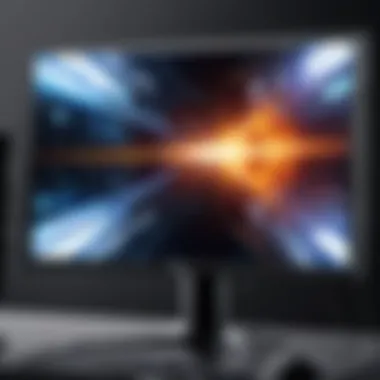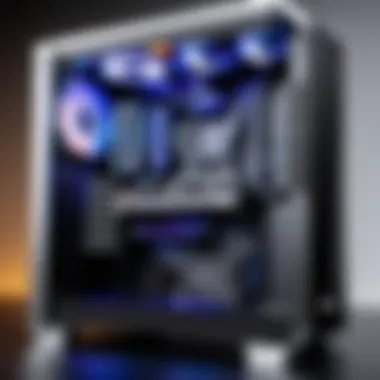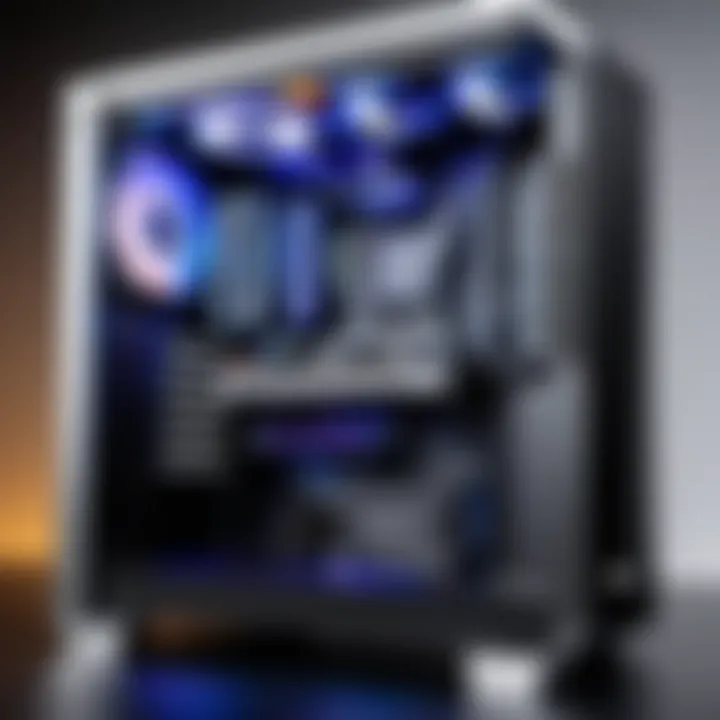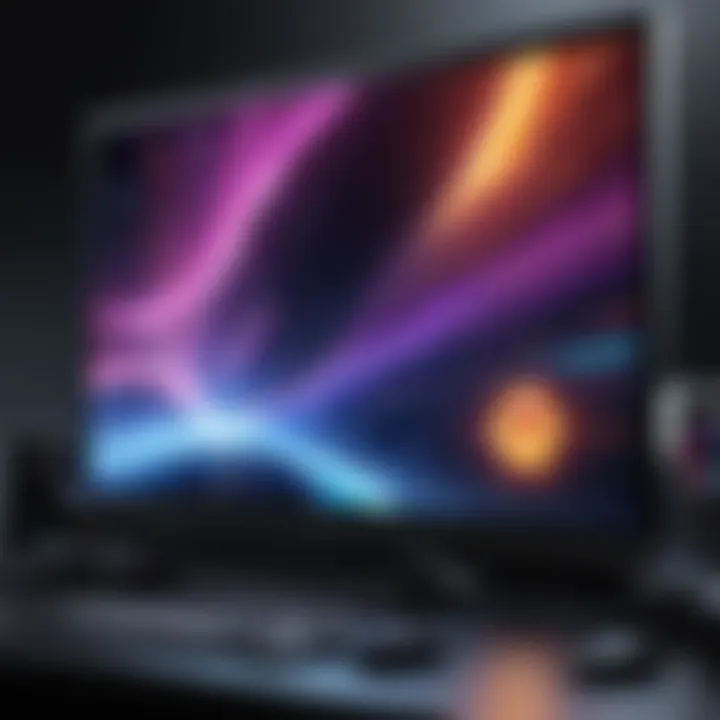Maximize Your Gaming: The Power of 144 Hz Displays


Intro
In the ever-evolving world of gaming, a 144 Hz display can be a game changer, quite literally. It's not just about visuals; it’s about creating a snappier, more responsive gaming experience that can leave competitors in the dust. When it comes to gaming PCs, these monitors can elevate gameplay, particularly in fast-paced genres like first-person shooters and battle royales, where every millisecond counts. But why is there so much buzz around 144 Hz displays?
The overall significance transcends mere specifications. This article aims to peel back the layers of gear, explore the hardware essentials, and clarify the oft-misunderstood intricacies of high refresh-rate displays. You'll find insights tailored for passionate gamers and even those who are new and just curious about upgrading their gear for more enjoyable adventures.
Equipping yourself with knowledge about 144 Hz displays can significantly impact gaming performance. As we delve into this topic, we will tackle essential components required for building an effective gaming PC setup, address the numerous benefits these monitors provide, and debunk common myths that often float around in the gaming community.
Prepare yourself as we turn the spotlight on an aspect of gaming that can transform your experience, delivering not only eye candy but also uncompromised performance.
Esports Coverage
When it comes to competitive gaming, esports has taken the world by storm, and you can’t ignore the critical role that hardware plays. In high-caliber tournaments, every detail in gameplay can tip the scales, and top-tier teams deeply understand how vital a 144 Hz display is in their arsenal.
Pro-Gaming Tournaments
Events like the League of Legends World Championship and the Overwatch League put immense pressure on players. Having a fast refresh rate allows them to react swiftly to in-game changes, offering a crucial edge over their opponents. The seamless visuals enable players to pinpoint enemy movements more accurately, leading to better tactical decisions.
Player Profiles and Interviews
To provide a deeper understanding, player insights can illuminate how they utilize their gear to perfection. For instance, professional gamers often share that their comfort relies heavily on the combination of high refresh rates with cutting-edge graphics cards. This synergy allows them to maintain smooth frames, crucial during high-stakes moments in-play.
Team Strategies and Analysis
Team strategies in esports often revolve around hardware capabilities. With high-refresh-rate screens, players can execute their strategies with precision, refining their skills during practice. The insight into contrasting team styles often reveals how different setups, particularly regarding displays and responsiveness, influence their game plans.
Hardware Testing
Now, moving beyond the competitive aspects, let’s take a closer look at the hardware itself, as the right components can greatly enhance a gamer’s experience.
Reviews of Gaming Monitors
What makes a monitor suitable for gaming? A review will often dig into specs like response times, adaptive sync technologies, and of course, that all-important refresh rate. Enthusiasts will discover phenomenal options such as the ASUS ROG Swift line or the Acer Predator monitors, which offer competitive features specifically designed for gaming.
Performance Analysis of GPUs
Equally critical is the graphics processing unit that powers that display. A high refresh-rate monitor can only be as effective as the GPU driving it. Performance analysis often highlights GPUs like the NVIDIA GeForce RTX 3080, which can consistently push out frames to take advantage of that 144 Hz offering.
Comparison of Mechanical Keyboards
While displays and GPUs often steal the limelight, don’t overlook peripherals like mechanical keyboards. A keyboard with fast switches complements a 144 Hz display by reducing input lag. Brands like Corsair and Razer have models that provide tactile feedback yet allow for speed, ensuring you won’t be left behind in the digital race.
Game Reviews
That said, it’s not all about the hardware; the games themselves play a significant role in bringing these systems to life.
Latest Game Releases
The dynamic nature of gaming means new releases almost every month. Games like "Valorant" and "Doom Eternal" are particularly noted for their high-fidelity graphics and frantic pacing, demanding a robust setup to showcase their full potential.
Detailed Gameplay Analysis
Diving deeper into gameplay, analyzing frame rates and performance logs reveals how much smoother gameplay can be with a 144 Hz monitor compared to traditional displays. Players can notice subtle differences that affect their overall satisfaction and proficiency.
Storyline and Graphics Review
Lastly, it’s worth mentioning that a good storyline, coupled with amazing graphics, creates an immersive environment. This is where the true synergy between the game and hardware shines. Titles like "Cyberpunk 2077" prove that visual aesthetics can be stunning when paired with an appropriate setup, and the display amplifies this interaction to fully engage players.
Intro to Hz Gaming
In the ever-evolving landscape of gaming technology, having the right display can make or break your experience. With the surge in popularity of fast-paced games, the importance of a 144 Hz refresh rate cannot be overstated. This pivotal feature not only enhances visual acuity but also demands specific hardware capabilities to fully realize its benefits. For enthusiasts and competitive gamers alike, understanding this aspect is crucial.
Defining Refresh Rate
At its core, refresh rate refers to how many times per second a monitor updates its image. Measured in Hertz (Hz), it dictates the smoothness of motion on-screen. A standard display often operates at 60 Hz, meaning it refreshes the image 60 times each second. However, with a 144 Hz monitor, this figure jumps, allowing for 144 updates per second.
The significance of this increase is monumental, especially in fast-paced scenarios where every millisecond counts. Picture this: you are in the thick of a high-stakes match, trying to line up the perfect shot. A higher refresh rate ensures that your monitor can keep pace with your movements—resulting in smoother visuals and less motion blur. This translates to a marked advantage in competitive gaming, where split-second decisions can pivot the outcome of a match.


The Rise of Gaming PCs
The gaming community has evolved rapidly, particularly over the last decade. Once limited to a small niche, gaming has become mainstream with the advent of gaming PCs. The rise of powerful hardware options has propelled this shift, giving gamers the ability to customize their setups to fit their specific needs.
The demand for high-performance components has grown exponentially, leading manufacturers to innovate tirelessly. Now, individuals can assemble machines that not only handle high frame rates but also support advanced technologies such as G-SYNC and FreeSync, aimed at reducing screen tearing.
"With the right setup, gaming PCs can deliver a cinematic experience right in your living room."
In light of this, the integration of 144 Hz displays has become a natural progression for many hardcore gamers. These monitors pair perfectly with potent components, promising not only improved visuals but enhanced gameplay dynamics. As more gamers invest in their setups, understanding the essentials of 144 Hz displays becomes paramount to leveraging their capabilities and enhancing their overall gaming experience.
Components of a Gaming PC
When discussing gaming PCs, the term "gaming rig" often crops up, but what makes it truly a rig? At its core, a gaming PC's capabilities are heavily influenced by the specific components that go into it. These elements work harmoniously to deliver the high-performance gaming experience that players crave, especially in fast-paced environments demanding quick responsiveness. Whether you’re battling in the latest AAA title or jumping into an indie game, the components can significantly enhance both performance and enjoyment. This section delves into the major parts of a gaming PC, underscoring why each is essential when paired with a 144 Hz display.
Central Processing Unit (CPU)
The CPU is often termed the brain of the computer, and understandably so. It handles all the instructions from the software, performing calculations and executing commands. For gaming, a robust CPU ensures that processes run smoothly, allowing for quicker game loads and reducing stutters during intense scenes. Consider CPUs with multiple cores; they can handle games more efficiently, especially those optimized for multi-threading.
When thinking about gaming, look for reliable brands like Intel and AMD, often mentioned alongside respective series numbers like Intel's Core i7 or AMD's Ryzen 7. Choosing a CPU that can keep pace with your GPU is vital because it prevents bottlenecks that can hamper performance.
Graphics Processing Unit (GPU)
If the CPU is the brain, then the GPU is undeniably the heart. Graphics cards are responsible for rendering images, animations, and video for display, making them paramount for the gaming experience. When you're playing at 144 Hz, the GPU must output quick and consistent frame rates.
With GPUs from NVIDIA, such as the RTX 3080, or AMD's Radeon RX 6800 XT, you're looking at technology designed for high refresh rates and deep graphical detail. These cards come with features that improve realism and responsiveness, such as ray tracing and DLSS (Deep Learning Super Sampling) capabilities. A powerful GPU is non-negotiable for anyone serious about gaming; it's where most of the visual enhancements stem from.
Motherboard and RAM
Think of the motherboard as the backbone of your gaming PC. It's where all components, including CPU and RAM, connect and communicate. Depending on your choice of CPU, you'll need a compatible motherboard, with features that support the speeds you want.
RAM, or Random Access Memory, plays an equally important role. Generally, 16GB of RAM is the standard for gaming today, providing enough memory for smooth multitasking. However, as games become more demanding, 32GB may be advisable for avid gamers who run multiple applications—streaming, recording, or running mods. Still less is indeed more if you're on a strict budget, so choosing how much RAM you truly need can be a balancing act.
Storage Solutions
Gone are the days when mechanical hard drives were the only option. SSDs, or Solid State Drives, have taken over, and for good reason. They greatly outperform traditional HDDs, loading games faster, facilitating quick access to data, and overall improving the system's responsiveness. A combination of SSDs and HDDs can often yield the best of both worlds—speed for your operating system and select games, while ensuring there is enough space for ample storage.
Purchasing an NVMe SSD, which utilizes the PCIe slot, can provide even greater speeds compared to SATA SSDs. For the passionate gamer, quick loading times can jump from mere seconds to a fraction of that, allowing for a more engaging and less interrupted gaming session.
Cooling Systems
It's often said that heat is the enemy of performance. In gaming PCs, excessive temperatures can lead to throttling, where components slow down to avoid overheating. Effective cooling systems come in two forms: air cooling and liquid cooling.
Air cooling typically involves fans and heatsinks—affordable and effective for many mainstream builds. Liquid cooling can be more effective and quieter, offering superior thermal performance for those diving into overclocking. Good thermal management extends the lifespan of your components, ensuring that your rig runs smoothly over time—nobody wants their system crashing mid-game.
It's crucial to strike a balance between performance and temperature control, as gamers will push their hardware to its limits.
An efficient gaming PC isn’t solely about having the most expensive components; it's about finding the right blend that complements your gaming needs and preferences.
Understanding these components lays a solid foundation for knowing how to build or purchase a gaming PC that can truly take advantage of a 144 Hz display while delivering a high-quality gaming experience. Each piece plays a pivotal role in crafting a system that meets the demands of today’s gaming environment.
The Importance of a Hz Refresh Rate
The importance of a 144 Hz refresh rate in gaming cannot be overstated. It’s akin to having a finely tuned sports car; when set up correctly, it greatly enhances performance. Having this refresh rate means the display can refresh the image on your screen 144 times per second. For gamers, especially in fast-paced games, this translates to a significant edge. Higher refresh rates lead to smoother gameplay and sharper visuals, making that sweet headshot a lot easier amid chaotic actions.
When it comes to competitive gaming, the difference can mean the world. Many players claim that a gaming rig that supports a 144 Hz refresh rate feels drastically more responsive and immersive. In practical terms, this means lower input lag and less motion blur; fast movements appear more accurate, and it is possible to react to enemies faster. Let’s not forget the satisfaction that comes with seeing your character’s clean movements flow seamlessly across the screen.
"True advantage in gaming lies not only in strategy and skill but also in the tools that facilitate victories."
In addition to heightened responsiveness, the 144 Hz refresh rate also helps to alleviate eye strain during extended gaming sessions. Eye fatigue often plagues those who spend hours glued to a screen. A higher refresh rate can smooth out frames, reducing flicker and creating a more comfortable viewing experience. In other words, you can game for longer, without feeling like your eyes are about to pop out of your head.
Enhanced Gaming Experience
The enhanced gaming experience goes beyond the technical perks of having a 144 Hz monitor. For many gamers, it’s about immersion. When graphics are rendered smoothly, it creates an environment that feels more real. Picture yourself dodging bullets in a tense shooter game; when the visuals flow beautifully, you can almost feel the adrenaline rush right alongside your character.
When you combine a high refresh rate with faster graphics cards, the synergy becomes evident. Quick movements are tracked efficiently, and environmental details become much clearer. This is where the significant difference truly sets in. Unlike a 60 Hz display, which might make your actions seem sluggish, a 144 Hz display keeps everything dynamic and lively, as if you’re placing your own touch on a virtual canvas.
In competitive scenarios, having this edge can create not just an experience, but a winning strategy. You want your monitor responding to your every move, precisely reflecting your intentions. With the crowded gaming world today, using outdated tech can feel like wearing brick shoes in a race.
Comparing Refresh Rates


Now, let’s delve into how 144 Hz compares to other refresh rates. Standard displays usually operate at 60 Hz. While this hasn’t been entirely phased out, the tech landscape is quickly evolving. While playing a game on a 60 Hz monitor might just get you by, the experience can feel sluggish. The difference becomes apparent when you start comparing experiences through multiple monitors side by side.
Below is a quick breakdown of how common refresh rates compare:
- 60 Hz: Satisfactory for casual gaming; acceptable for most single-player experiences.
- 120 Hz: Offers better fluidity; practically feels twice as responsive compared to 60 Hz. Ideal for multiplayers and casual competitive gamers.
- 144 Hz: A sweet spot for committed gamers. This rate provides a noticeable impact on performance and is recommended for most competitive situations.
- 240 Hz: Great for enthusiasts and the extremely competitive, but makes less sense for casual experiences.
As technology progresses, it's worth keeping an eye on upcoming developments. The comparative advantages of high refresh rates contribute not just to performance but offer a clear path toward future technologies.
Understanding Frame Rates vs. Refresh Rates
When diving into the world of gaming, especially with a setup equipped with a 144 Hz display, the distinction between frame rates and refresh rates becomes critical. It's one of those topics that, once understood, can truly amplify your gaming experience. This section will illuminate why these terms matter, what separates them, and how they contribute to the performance and visual quality of video games.
Frame Rate Explained
Frame rate refers to the number of frames that a computer generates each second while rendering graphics. Measured in frames per second (FPS), it directly influences how smooth your gameplay feels. Imagine watching a movie; if the frames skip or lag, the viewing experience becomes jarring and difficult to enjoy. In a gaming context, high frame rates translate to more fluid action, better responsiveness, and an overall engaging experience.
For instance, if a game runs at 60 FPS, that's great for many casual users. However, with a 144 Hz monitor, if you're still only reaching 60 FPS, you’re missing out on what your monitor can truly deliver. Many gamers seek to push their systems to achieve at least 144 FPS, allowing them to fully utilize their ultra-responsive screens, providing that buttery-smooth experience that keeps you in the action seamlessly.
"In gaming, higher frame rates lead to better accuracy and control, especially in fast-paced genres like first-person shooters."
Interaction of Frame and Refresh Rates
To truly grasp the synergy between frame and refresh rates, think of them as two partners working in tandem. The refresh rate is how often your monitor redraws the image on its screen, while the frame rate is the computer's output of images. If your graphics card is consistently pumping out 120 FPS, but your monitor only refreshes at 60 Hz, you're essentially watching a race with a speed limit; it just won’t keep up.
This discord can lead to a phenomenon known as tearing, where portions of multiple frames appear on the screen at once, ruining the visual fidelity of the gaming experience. Conversely, if you’re running a game at 180 FPS on a 144 Hz monitor, the refresh provides a smooth experience without stuttering. This allows you to harness all that raw power from your GPU.
When both frame rate and refresh rates align harmoniously, you find the pinnacle of gaming performance, creating a seamless visual journey where every keystroke or mouse movement is mirrored on the screen. The optimizations can take some tuning, yet the results are undeniable with stutter-free visuals and fluid gameplay — the kind that's essential, especially in competitive gaming environments.
It's also worth noting technologies like V-Sync that aim to reduce tearing by syncing frame rates to refresh rates, providing another layer of enhancement to your gaming experience. However, be wary; the downside of V-Sync can sometimes introduce input lag, a factor competitive gamers generally try to avoid.
In summary, understanding frame rates and refresh rates isn't simply academic. It's about getting the most out of your gaming rig and monitor. Together, they hold the key not only to immersive gameplay but also to peak performance.
Choosing the Right Monitor
When it comes to gaming, the monitor often plays a crucial role in the overall experience. Choosing the right monitor is not merely about picking something with a stunning screen. Factors like size, refresh rate, resolution, and available technologies matter significantly, especially if you aim to get the most out of your 144 Hz gaming setup. The difference between a mediocre experience and an engaging one can hinge on the precise choices you make while selecting your display.
Size and Resolution Considerations
The dimensions of your monitor can greatly influence your immersive experience. A larger screen can pull you deeper into your games, while a smaller one might not have the same effect. But size isn’t everything. Do consider the resolution too—whether it be 1080p, 1440p, or even 4K. Each comes with its perks:
- 1080p (Full HD): Quite popular among gamers; it strikes a balance between performance and quality. You will find that most games run smoothly at this resolution, especially on a monitor with a 144 Hz refresh rate.
- 1440p (QHD): Offers a noticeable bump in clarity. This is where pixel density steps up, making fine details pop against the backdrop of demanding scenes. A monitor of this caliber means you’ll need a solid GPU to keep frame rates high.
- 4K (Ultra HD): Not just for the visually fancy, but it requires top-tier hardware to run smoothly at high settings. This resolution is more demanding but will provide breathtaking visuals when handled correctly.
Keep in mind your available space too. Large monitors might require adjustments in your actual gaming setup. Also, consider your viewing distance. If you’re sitting too close to a big display, it might become tricky to see the entirety of the screen without turning your head.
Adaptive Sync Technologies
In the gaming world, fluidity is king, and adaptive sync technologies like AMD FreeSync and NVIDIA G-SYNC contribute massively to this quest for visual smoothness. These features dynamically adjust the monitor’s refresh rate to match the GPU’s output, minimizing issues like screen tearing, stuttering, and input lag. This is extremely vital for competitive gamers where every millisecond counts.
- AMD FreeSync: This is usually more cost-effective and widely supported among several brands. Notably, it allows for seamless synchronization between AMD GPUs and monitors, ensuring a smooth gaming experience without additional costs for licensing.
- NVIDIA G-SYNC: Offers a fantastic experience but tends to come with a premium. Compatible with a selection of monitors, G-SYNC can significantly improve the gaming experience by providing a more steady and responsive feel.
More recently, some monitors support both technologies, reaching a point of accessibility where either user can reap the benefits without financial strain. It’s well worth considering which of these technologies best fits your gaming preferences and hardware.
"A good monitor can elevate your gaming experience to another level, making it not just about what you're playing, but how you're feeling about it too."
Overall, understanding the elements surrounding monitor choices is key to improving how you experience your games. The right balance can make all the difference, helping you elevate your gaming experience far beyond just pixels.
Optimizing for Performance
When it comes to gaming, squeezing out every ounce of performance from a gaming PC with a 144 Hz display is nothing short of essential. This goes beyond simply having the right hardware; it involves refining each component, ensuring they work harmoniously to deliver a seamless experience. In high-octane gaming scenarios, where even milliseconds can mean the difference between victory and defeat, optimization becomes paramount. Let's explore some key aspects that can propel your system performance to new heights.
Overclocking Capabilities
Overclocking is a term that strikes a chord with many tech enthusiasts. It’s akin to giving a boost of nitrous to your car—adding extra power and increasing speed. Overclocking allows you to push your CPU or GPU beyond the manufacturer's rated specifications, unlocking additional performance potential. For a gaming rig, this translates to better frame rates, reduced input lag, and an overall enhanced experience.
But, it comes with a caveat. Each chip has its limits; pushing it too hard can lead to overheating and even permanent damage. Users must take precautions: invest in quality cooling solutions and monitor temperatures vigilantly. Here are some tips to consider:
- Know Your Hardware: Each component has different overclocking limits. Research your specific CPU or GPU model.
- Gradual Increments: Never make drastic adjustments. Tweak settings in small steps and benchmark the changes.
- Stability Testing: Always run stress tests after overclocking to ensure your system remains stable during intense gaming sessions.


In short, overclocking can dramatically elevate your gaming experience, provided it's done with care and precision.
Updating Drivers and Software
Just like a car needs regular maintenance for optimal performance, gaming PCs also require updates to drivers and software. Outdated drivers can act like roadblocks—stopping your system from harnessing its full potential. For graphics cards, manufacturers regularly release updates designed to improve performance in new games and fix bugs.
Updating isn't just about fixing what’s broken, though. It often introduces new features that enhance performance, such as optimizations for 144 Hz displays or better integration with adaptive sync technologies. Here’s what you should focus on:
- Automatic Updates: Ensure your operating system is set to update automatically, reducing the hassle of manual checks.
- Graphics Drivers: Regularly visit NVIDIA’s or AMD’s website to download the latest drivers tailored for your GPU.
- Game Launchers: Platforms like Steam, Epic Games, or Battle.net often release patches or updates to enhance game performance; ensure these are not ignored.
"Optimizing your setup might seem like a chore, but it pays dividends when the action gets intense."
Every little performance enhancement can make a big difference, especially in competitive gaming.
By focusing on overclocking and timely updates, you can unleash the full potential of your gaming PC, enabling it to perform at its best and complement the capabilities of a 144 Hz display.
Common Misconceptions
In the realm of gaming, there are plenty of myths that can mislead both seasoned pros and newcomers alike. When discussing 144 Hz displays, understanding these misconceptions might just save you from spending your hard-earned cash on something that doesn’t necessarily boost your gaming experience as expected. So let's take a closer look at some common fallacies surrounding higher refresh rates and gaming PCs.
Higher Refresh Rates Not Always Better?
It may seem like a no-brainer: higher refresh rates mean better visuals, right? Not exactly. While having a display with a 144 Hz refresh rate is certainly better than a 60 Hz one, it doesn't automatically guarantee a more enjoyable gaming experience. Here’s why:
- The Limitations of Your Hardware: If your CPU or GPU can't churn out enough frames per second, you might not see much difference even with a 144 Hz monitor. You could be looking at a good display but your system’s guts just ain't up to snuff.
- The Game's Capabilities: Some games inherently do not support high refresh rates. Think about older titles or less demanding indie games—they might not push the hardware to create those rapid visuals.
- Type of Gameplay: Fast-paced first-person shooters benefit the most from higher refresh rates. However, turn-based strategy games? Not so much. In those cases, focusing on visuals and story may take precedence over raw refresh capabilities.
Still anxious to jump on the 144 Hz bandwagon? Well, keep in mind that just because you can, doesn’t mean you should without considering your own setup and gaming preferences.
Gaming PC Cost vs. Performance
When talking about gaming PCs, many people fall into the trap of equating cost with performance. Sure, a high price tag can often mean better components, but it doesn't always translate to superior performance. Here's what you need to weigh:
- Overpriced Parts: Some brands cash in on their reputation and drive up prices while offering marginal gains. Just because a GPU is expensive, doesn’t mean it’s the best choice for your needs.
- Balancing Components: High performance is all about balance. Spending a fortune on a top-tier GPU is pointless if your CPU can't keep up. A well-rounded system often provides better performance in real-world scenarios than a top-heavy configuration.
- Return on Investment: It’s easy to get swept away in the latest tech trends and drop a significant amount on gear. However, if you're just casual about gaming, it’s wise to think about where your money is best spent. You may not need that high-end graphics card if you're mostly playing simpler games.
"The cost of a gaming PC is only part of the equation; understanding what you actually need for the games you play is what really counts."
Navigating through these common misconceptions allows gamers to make informed decisions. This is crucial not only for optimizing performance but also for ensuring that the money spent on technology enhances the experience rather than just adding another number to your bank statement.
Future Trends in Gaming Displays
As gaming technology continually evolves, staying ahead of the curve becomes essential for gaming enthusiasts, technology aficionados, and anyone dabbling in the world of gaming. Understanding future trends in gaming displays is not just about knowing what’s next; it’s also about how these innovations can elevate the gaming experience, improve performance, and ensure your setup remains relevant for years to come.
Advancements in Technology
The realm of gaming displays is one that’s driven by innovation. In recent years, several technological advancements have emerged, fundamentally transforming what gamers can expect from their screens. For instance, Mini-LED and OLED technologies have taken center stage. Mini-LED offers enhanced brightness and contrast by using tiny LEDs as a backlight, leading to better black levels and color accuracy. This creates a visual experience that can be more immersive, especially in darkly themed games.
On the other hand, OLED panels provide absolute black levels due to their ability to turn off individual pixels, resulting in stunning visuals that gamers can appreciate. Coupling these advancements with 144 Hz refresh rates increases fluidity and responsiveness, further enriching gameplay.
Moreover, technologies like 360Hz displays are already being tested, catering particularly to competitive gamers. While 144 Hz is currently the sweet spot for most gamers, the subtlety of even higher refresh rates should not be dismissed, as the lines between reality and gaming graphics continue to blur.
"Technology is constantly evolving; what we consider cutting edge now may soon become standard practice. Staying informed is crucial."
The Shift Towards Higher Resolutions
As gaming hardware improves, the trend towards higher resolutions cannot go unnoticed. Full HD (1920x1080) became the standard not too long ago, yet many gamers are now embracing 4K resolutions, with some opting for even higher, such as 8K, especially for ultra-realistic gaming experiences.
Higher resolutions provide more detail and clarity. This opens up a new level of immersion in games, allowing players to notice finer details they might have overlooked before. With the combination of 4K or higher resolution displays and 144 Hz or more refresh rates, gamers can experience ultra-smooth visuals that feel more lifelike. However, it’s vital to note that higher resolutions demand more from your gaming PC.
For the best experience, users will need to invest in powerful graphics cards that can handle the increased pixel counts while maintaining high frame rates. Balancing cost, performance, and future-proofing your setup becomes essential as you navigate these options.
To wrap it up, the trends pointed here indicate a clear trajectory towards better resolutions and innovative technologies. Keeping a pulse on these developments will serve as a compass, guiding gamers in making informed choices about their hardware investments.
Ending
In wrapping up the extensive exploration of gaming PCs equipped with 144 Hz displays, it's crystal clear that the significance of refresh rates can't be ignored. A 144 Hz refresh rate doesn't just tick boxes; it fundamentally revamps how gamers experience their favorite virtual worlds. The smoothness in motion, the responsive gameplay, and the stunning visuals all linked to this specification play a monumental role. For esports enthusiasts and casual players alike, understanding these elements not only enhances their gaming sessions but also informs their purchasing decisions.
Summarizing Key Points
Here are some of the crucial takeaways from this discourse:
- Refresh Rate Matters: The leap from traditional displays to 144 Hz can markedly enhance gameplay, minimizing blur and providing a clearer picture during fast-paced scenes.
- Core Components Count: A well-rounded gaming PC, from the cutting-edge CPU and GPU to efficient cooling systems, ensures the experience is optimized for high refresh rates.
- Monitor Selection is Key: Picking a monitor that fits your gaming style and preferences can make or break how you play. Consider size, resolution, and adaptive sync technologies to fully embrace what 144 Hz has to offer.
- Optimization is Ongoing: Regular updates to drivers and potential overclocking can push your system to its limits, ensuring you get every ounce of performance available.
- Debunking Myths: It's essential to sift through misconceptions like the belief that higher refresh rates always mean better visuals, as personal preference and system balance also matter greatly.
Final Thoughts on Gaming Performance
When it comes to gaming performance, aiming for a 144 Hz display might seem like tossing your chips onto a gamble. However, for those who take competitive play seriously or simply wish to enhance their enjoyment, it's a worthy investment. The beauty of a well-tuned PC setup lies not just in the numbers but in the experience it delivers. As technology progresses, expectations continue to rise, making the need for clarity and responsiveness paramount. So, whether you're squaring off against opponents in a competitive arena or immersing yourself in a rich, narrative-driven title, the quest for the ultimate gaming experience is underscored by understanding the essentials tied to 144 Hz displays.



